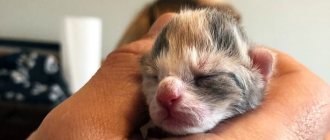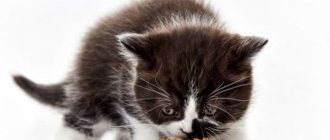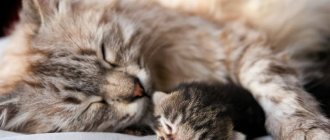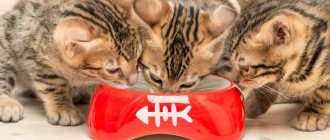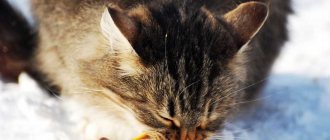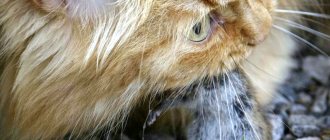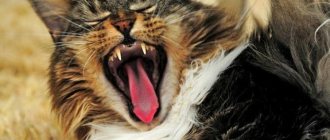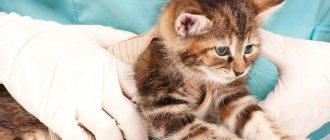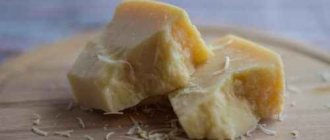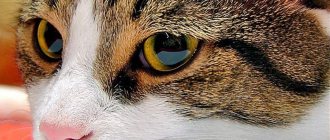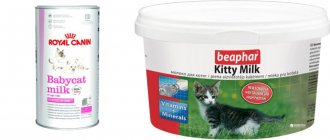For strong immunity and the proper formation of a kitten’s internal organs, nutrition plays an important role, starting from the first days of life. Mother's milk, which is secreted during lactation, provides babies with all the necessary nutrients, as well as immunocompetent cells that protect the body from many diseases.
If a kitten is left without a mother at an early age, special attention should be paid to its feeding.
Growth stages and needs of kittens from 0 to 30 days
In the first month, kittens experience processes of growth and development of the body; proper care during this period allows them to improve their health and avoid diseases in the future.
- The neonatal period lasts from the day the baby is born until 10 days. At this time, rapid noticeable changes in internal organs and external signs occur. Newborn kittens navigate thanks to two sensory systems - tactile and olfactory, since their eyes are closed and the auditory canal is not fully formed. Babies spend most of their time sleeping. Around the fifth day, the kitten begins to hear.
- The transitional stage begins at day 10 and lasts until day 20. At this time, kittens open their eyes, which means the central nervous system is maturing. It is believed that this stage is favorable for establishing good contact between the owner and the pet. Veterinarians recommend teaching your baby to hold hands. From the 10th day, the time spent with the owner should be about 4 minutes; as they grow older, the duration reaches 40 minutes a day. Regular communication with your pet is the key to a friendly relationship.
- The socialization stage begins when the baby takes his first steps. From this moment on, it is easier for the kitten to learn about the world around him. At the same time, the formation of the nervous system, adaptation mechanisms and socialization occurs.
What to feed a newborn kitten if the mother is not around
The menu for kittens left without a mother is subject to very strict requirements. Food should be high in calories to ensure rapid weight gain:
- kittens up to 7 weeks require 628 J of energy per day;
- from 20 weeks - 837 J;
- from 5 months - 963 J.
Solid foods are strictly contraindicated - babies need soft, easily digestible food.
Is it possible to give cow's milk
Regular milk is not suitable for kittens, as it is too fatty and causes severe diarrhea. It can only be used as a base for preparing natural mixtures (not powder). In this case, it is permissible to take pasteurized cow's milk with a fat content of no more than 3% and mix it with egg yolks and multivitamins.
When feeding your baby, you must monitor the quality of his digestion. If the animal refuses to eat or after eating food there is a problem with defecation, severe bloating and seething in the abdomen, in this case you will have to switch to special food for newborns.
Formulas for newborn kittens are closest in composition to mother cat milk
Milk replacers for kittens
There are many artificial formulas suitable for newborn kittens. When purchasing, be sure to study the composition. The protein and fat content should be close to 35% and 25%, respectively. Mandatory are:
- lactose;
- minerals;
- vitamins B1, B2, B4, B5, C, E, K3;
- Omega-3, Omega-6;
- zinc, iron and iodine.
Without these components, the kitten will not be able to develop normally.
Beaphar
The Dutch Beaphar Kitty-Milk formula is suitable for kittens from birth until 35 days of age. It costs approximately 890 rubles for a package weighing 250 grams. The composition contains all the necessary nutrients, amino acids, vitamins, minerals and trace elements in the correct ratio (this information has been verified and confirmed by the European Veterinary Union). Protein in the mixture is 34%, fats are 24%.
Gimpet
Fortified milk Gimpet Cat-Milk (Germany) contains an increased amount of taurine and is suitable for the rehabilitation of weakened, emaciated kittens. The price of a package weighing 200 grams is from 610 rubles. The protein content in the product is 35%, fat - 27%.
Hartz
The American product Hartz Milk for Kittens is considered the most widespread artificial formula in the world for feeding newborn kittens. It can be given from the first day the baby is born until 35 days of age. The protein and fat content of Hartz is 32% and 29%, respectively. The product is not fortified, so when preparing it you must add a multivitamin. Price - from 320 rubles per package.
Royal Canin
Royal Canin Babycat Milk cat milk replacer can be purchased for 1200–1500 rubles (this is the price for a large package weighing 2 kg). The peculiarity of the product is that, in addition to vitamins and milk protein, it contains:
- soybean and coconut oils;
- fish fat;
- fructooligosaccharides.
These substances are intended for the proper formation of the kitten’s bones, hair growth, and strengthening the immune system. Due to aromatic additives, the mixture becomes as similar in smell to cat milk as possible, so babies readily eat it.
Canina
Canina Katzenmilch is recommended for kittens intolerant to natural milk - this product is completely lactose-free. The protein and fat content corresponds to the norm - 30% and 25%. The composition contains minerals (phosphorus, magnesium, sodium and calcium), but no vitamins are added; the kitten will have to be given them additionally. Packaging price - from 700 rubles per 150 grams.
Table: other mixtures for newborn kittens
| Name | Price/package weight | Protein and fat content | Features that distinguish it from other mixtures |
| Nutri-Vet Kitten Milk | From 860 rub. for 170 g | 42% and 25% |
|
| Kittenmilch CDVet | 1100 rub. for 90 g | 29% and 22% | Not the most high-calorie product (so the powder will have to be mixed with egg yolk), but it contains a full range of vitamins and minerals |
| TROVET Kitten Milk KMS | 1190 rub. for 400 g | 27% and 25% | Contains:
|
Photo gallery: ready-made formulas for feeding kittens
Beaphar Kitty Milk formula for kittens is a complete replacement for mother's milk for orphaned, abandoned or lost kittens
Hartz Precision Nutrition Milk Replacer for Kittens (with taurine) is suitable for feeding kittens from birth to 5 weeks of age (35 days)
Kittenmilch CdVet is a milk replacer for kittens with colostrum, an absolutely natural product for feeding feline offspring.
Nutri-Vet Kitten Milk contains the required amount of proteins, fats and carbohydrates, vitamins, minerals and amino acids that newborn kittens need. Advantages of TROVET Kitten Milk - high palatability, energy value and fat content comparable to mother's milk
Royal Canin Babycat Milk cat milk replacer has a rich vitamin and mineral composition
The fortified mixture Gimpet Cat-Milk in composition corresponds to natural cat milk and contains all the necessary vitamins
Canina Katzenmilch is an unsurpassed mother's milk substitute and contains 30% easily digestible protein, which is essential for a growing kitten.
How to determine age, make a nest
The age of kittens is determined by several criteria:
- in the first three days a fresh umbilical cord is detected, later it falls off on its own;
- eyes open one and a half to two weeks after birth;
- the reaction to sounds appears from the fifth day, in addition, age can be calculated by the state of the ears - they are pressed to the surface of the head until the ear canal opens, then straightening occurs;
- by the third day of life, the baby weighs on average 100 g, after a week the weight gain is approximately 50 g, at the age of one month the baby’s body weight is 250 g;
- milk teeth appear in two-week-old kittens - the incisors grow first, then the fangs at the fourth week, all milk teeth appear by 4 months.
To create a cozy nest for kittens, you can use a small cardboard box. Since pets at an early age have a small body weight and an immature thermoregulation system, it is recommended to take care of heating.
For this purpose, use a heating pad and a cloth that is placed on the bottom of the box. Favorable temperature conditions range from 25 to 28-29 degrees.
How to feed newborn kittens
To feed a kitten without a cat, you should purchase a special formula. Veterinarians do not recommend giving newborns cow's milk and fermented milk products. To do everything correctly, you must adhere to several rules.
- First, the pet is carefully placed on its stomach.
- The milk mixture is fed using a pipette, a bottle with a nipple at the end, or through a syringe without a needle. The food is preheated to a temperature of 36 degrees.
- Feed should be fed dropwise in several passes so that the baby has time to make swallowing movements.
- After feeding, to stimulate urination and defecation, gently massage the abdominal area and anus with a finger or cotton wool soaked in warm water.
Tips for feeding a kitten
Raising kittens without a cat, especially for the first time, requires a lot of effort, patience, and skills. The following tips will help you overcome difficulties and tell you how to get out of a difficult situation.
- The kitten has eaten the amount allotted for its age, but continues to suck. How to proceed? Immediately a fear arises - he doesn’t have enough, he hasn’t eaten enough, I must add. It's worth checking your tummy. Round and elastic, it indicates that there is enough food. The kitten just got carried away, or didn’t realize that it was full.
- The baby does not drink the dose prescribed for his age. Perhaps he is sick. Or this is a feature of the body - it eats less food. If he behaves on par with the other kittens and does not seem weak, then everything is fine. Otherwise, you need to show it to a specialist.
- The kitten must be fed at night. This is a feature of the body of a newborn, like a baby. If this is not done, digestion will be disrupted and health problems will arise. At night, kittens will meow, look for food, and not sleep.
- The portion should be divided into 2 times. Initially, the baby pounces on the food and sucks greedily. Having drunk it all, he does not realize that he is full and feels hungry. Then proceed as follows. They feed one kitten; when it drinks half of it, they stop feeding it. They move on to the second baby. They do the same. Then they return to the first baby again. In this case, he will eat calmly, and the feeling of fullness will come on time.
- The mixture is prepared in portions before feeding. The digestive system is such that it cannot tolerate “yesterday’s” or “morning” food. There is bloating, fermentation, pain. It is better to heat food in a water bath.
- The kitten does not take the pacifier, pipette, or the tip of the syringe; you must carefully insert it into the mouth and squeeze out a little of the mixture. To stimulate sucking, you need to stroke his back and forehead.
- When feeding a kitten, you need to make sure that the head does not tip back too much. In this case, he does not have enough breath, which leads to difficulties. The kitten may choke, choke, or suffocate.
- To determine whether the baby is full or not, you need to observe his behavior. A well-fed kitten will turn away from the pipette and calmly go to bed. A hungry baby will squeak, suck on his brothers, and look for a pacifier.
- It is better to buy milk for preparing the mixture at the market, not in the store. In this case, you can be sure of its natural origin and quality. If the milk contains food additives, preservatives, or water, it will not benefit the kitten. In addition, the mixture prepared according to the recipe will be low in calories, the baby will not get enough of it.
Feeding a kitten without a cat is a very labor-intensive and lengthy process. You need to quit all your business, not go to work, feed the babies every 2 hours day and night. The sacrifices must be justified.
An interesting fact remains that when such a situation arises in rural areas, kittens are fed fresh cow's milk from a pipette for literally a week. When they get to their feet, offer a small bowl. No special care. As a result, they grow up alive, playful, and healthy. They determine their own norm.
https://www.youtube.com/watch?v=r2ZCM15oLgw
Feeding frequency and weight gain
Small pets require large energy expenditures, since it is in the early stages that the growth rate reaches its maximum. This situation requires frequent meals - up to 5-6 times a day. As they grow older, the number of meals decreases - at 3 months it is recommended to feed a kitten three times a day.
Upon reaching six months, the animal is fed, like adults, twice a day. It is important to take into account your baby's weight gain; to do this, you should weigh him once a week. Stunted growth may indicate poor diet or illness.
Portions and calendar
A hungry pet clearly lets you know about the problem by squeaking; when it’s full, it purrs quietly. You can rely on your pet's signals, but it is better to calculate feeding portions in advance. During the first 7 days, the optimal dose is 30 milliliters of mixture per 100 grams of your kitten’s weight. Starting from the fifteenth day, a different norm is relevant: 35 ml. From 3 weeks you can feed your pet 40 milliliters of the mixture. Seven days later, the daily dose increases slightly. Baby meat purees can already be introduced into the diet of a one-month-old baby.
Features of feeding by month
In the first month, the kittens' diet consists of dairy products, to which other foods are gradually added. In the second week, complementary foods in the form of meat broth begin to be introduced. As the kitten grows, it is fed minced poultry meat. It is also recommended to give various cereals and egg yolk.
From 1 month onwards, the diet includes more solid food - meat cut into small pieces, fruits and vegetables.
By 6 months you should stop drinking milk in its pure form. This is due to the fact that the kitten noticeably decreases the secretion of the enzyme lactase, which breaks down disaccharides, so diarrhea, vomiting and general malaise occur when using the product. Milk is replaced with fermented milk products - fermented baked milk, cottage cheese.
As you grow, other foods besides the mixture are included in the diet; nutrition can be:
- natural;
- ready;
- combined.
For kittens, both the regimen and the feeding process itself are important. Insufficient food can lead to exhaustion or impaired development of the pet. Failure to follow feeding rules leads to aspiration of the respiratory tract with food and other pathologies.
Recipes for making your own mixture
If the kitten tolerates pasteurized cow's milk well, then you can make him dishes based on it. To prepare the classic recipe you will need:
- a glass of warm milk;
- 2 chicken egg yolks;
- vegetable oil - 1 teaspoon;
- 1 drop of multivitamin solution (for example, Trivita or Tetravita).
If the kitten is very weak and thin, you can prepare a sweet mixture based on condensed milk - it contains enough fats and carbohydrates so that the baby quickly gains weight and gets stronger. It is made according to the following recipe:
- Condensed milk is mixed with water in a ratio of 1:5.
- Add bone meal at the rate of 1 teaspoon per liter of liquid.
This dish is only allowed to be given to kittens over 1 week old. Suitable only for emergency feeding (after 5–7 days you should switch to a regular formula with milk or a powder substitute).
Video: how to make a mixture for kittens
Natural nutrition
Natural feeding implies a diet consisting of natural products. Contrary to popular belief, pets should not be fed from the owner's table; such feeding can lead to the development of diseases.
When choosing a natural diet, veterinarians advise consulting with them in order to correctly calculate the menu for your pet. Excess or deficiency of substances can lead to disruption of growth and development processes, and junk food provokes the formation of diseases.
Features of the natural diet of kittens
For a carnivorous predator, sufficient protein intake is important, so the basis of the diet is meat. Veterinarians recommend feeding chicken, turkey or beef, as these varieties contain the least amount of fat.
Weak meat broths are given to babies from the second week. Soft minced meat is gradually introduced, and from a month on you can feed your pet finely chopped fillet.
For proper osteosynthesis, that is, the development of the bone apparatus, as well as the formation of teeth, a sufficient amount of calcium, magnesium and other elements that are contained in dairy products is necessary. The kitten's diet includes fermented baked milk, cow's milk, and cottage cheese.
Vitamins are found in fresh vegetables and fruits. At an early age they are served as a puree. By one month, the kitten can eat finely chopped ingredients.
The source of phosphorus is fish. Preference is given to marine species. In this case, the product is boiled and cleaned of bones. It is more advisable to use fillet.
Advantages
Supporters of natural nutrition explain their choice by the fact that natural nutrition does not contain harmful compounds - preservatives, additives, dyes, flavor enhancers. In addition, a wide variety of foods has a beneficial effect on your pet's health. With a properly designed menu, natural feeding ensures a complete supply of all necessary nutrients.
Flaws
Feeding your pet natural food can lead to poisoning if a prohibited product gets into the diet. In addition, independently compiling a menu may not take into account the individual needs of the baby and lead to a deficiency of vitamins and minerals or, conversely, their excess.
Homemade formulas for newborn kittens
Your pet will surely like quick delicacies from famous brands. But the cost of these products hits a person’s wallet. When thinking about what to feed a newborn, people of modest means opt for homemade high-calorie drugs.
Here are popular recipes for cat milk substitutes:
- Sweet substance with vitamins. To prepare the mixture you will need a quarter glass of cow's milk, a teaspoon of milk powder, and a gram of vitamin supplements. A few drops of glucose will enhance the nutritional quality of the product. It is necessary to give such a delicacy to the animal in a heated form.
- Liquid delicacy. You will need condensed milk without sugar and boiled water. The ingredients are taken in a 5:1 ratio. The above ingredients are mixed. The egg yolk completes the milk “composition”.
- Rescue “cocktail”. Veterinarians advise feeding this mixture to a weak newborn kitten that barely squeaks, trembles, and looks exhausted. Prepare one hundred grams of fat milk, raw yolk, a tablespoon of a five percent glucose solution. The invigorating drug is heated (not much).
- Universal solution. The guardian will need two hundred grams of milk, two raw yolks, five grams of vegetable oil (we mean unrefined product).
Protein components should be varied.
If possible, starting from the age of one month, pamper small kittens with quail eggs twice a month. They contain many microelements. These substances normalize the activity of the endocrine system of a young cat. You can prepare the mixture yourself, but we do not recommend doing so: the mixture must be fresh, and any newborn eats often. Preparing homemade mixtures at night, according to a recipe, while listening to the loud squeak of a hungry cat is not the best pleasure.
Another way out is to give the kitten a grain-free infant formula for newborns. This mixture can be diluted with goat's milk, but it is not recommended to use cow's milk for this.
Ready-made feed
If the owner has chosen to eat ready-made food, it is necessary to decide on the manufacturer.
Ready-made food is purchased at a pharmacy or pet store. Preference is given to premium class. When choosing, take into account expiration date, composition, weight and age restrictions.
Some manufacturers make specialized foods designed for specific breeds. Such products take into account the individual characteristics of the jaw structure and the presence of a predisposition to diseases. Ready-made holistic feeds are considered the most optimal. This is a class of finished products that differs in its composition: only natural meat, fruits and vegetables are used, and the manufacturer does not add preservatives or dyes.
You should not give your kitten food intended for an adult. In most lines of finished products there is a distinction by age.
pros
The advantage of feeding ready-made food is that the owner does not need to calculate the pet's nutritional needs. The manufacturer, based on age, weight, breed and even temperament, adds certain nutrients to the product in the correct ratio.
In addition, such food is convenient when transporting your pet or traveling. Another advantage of store-bought food is that it saves time and effort spent on cooking.
Minuses
Cheap food, as a rule, does not meet the requirements of kittens and adults, since they contain insufficient nutrients. In addition, unscrupulous manufacturers add dyes, flavor enhancers and other chemical compounds to products that can cause an allergic reaction, poisoning and diseases of the digestive tract in the pet.
Happy Cat Junior
Belongs to the holistic class. The food is intended for babies aged from one month to one year. The products include fresh dietary meat, salmon, as well as vegetables and fruits. In addition, the manufacturer also takes into account the consistency of the food so that the kittens can eat without difficulty.
1st Choice
The product belongs to the super-premium class - lower than holistic ones. Among the advantages are lower cost and the use of natural products. A special feature of the food is the addition of salmon fat, which contains essential lipids involved in many life processes, including brain activity. The disadvantage is the small range of feeds.
Purina ProPlan
Ready-made dry food intended for kittens aged one and a half months to a year, as well as wet food for pets up to one year. The line belongs to the premium class. The main advantages are reasonable price, wide distribution in stores, high-quality composition. The disadvantage is the presence of vegetable fats and the possibility of an allergic reaction to the components.
Prohibited Products
It is recommended to feed the kitten only with approved products; you cannot experiment. It is strictly forbidden to give your baby:
- Undiluted cow's milk . It is very heavy and difficult to digest, especially by the unformed digestive tract of a newborn kitten. Feeding your pet cow's milk will lead to severe indigestion, from which he may die.
- Cream is an extremely harmful product for a kitten’s digestive system and overall health.
- High fat dairy products . The higher the percentage of fat content in a product, the greater the impact on the liver and the risk of developing indigestion.
- Premature feeding with meat and sausages . The kitten, of course, will like the smell and taste of meat, but its gastrointestinal tract is not able to digest heavy food. The consequences of such complementary feeding can be extremely disastrous.
If you have to independently feed a kitten deprived of its mother cat, it is best to consult a veterinarian.
Additional care for newborn kittens
When a kitten is left without a mother, it is important not only to provide adequate nutrition and good living conditions, but also other care. A cat, licking the baby's belly, stimulates the reflexes of urination and defecation, so doctors recommend carrying out the procedure yourself using a gentle finger massage - circular movements are made in the pelvic area, where the urethra and anus are located.
If the baby cannot empty his bowels, an enema is used. The manipulation is carried out using a 5 ml syringe without a needle, which is filled with warm water. The tip is lubricated with castor oil or Vaseline and inserted into the rectum, after which the contents of the syringe are injected.
1111
Dishes for feeding kittens
You can feed kittens from bottles and syringes purchased at the pharmacy. Often, an ordinary disposable syringe without a needle is used for this purpose. The syringe must be replaced with a new one throughout the entire feeding period. Its lower end is sometimes rounded, treated with thin sandpaper or a file. Even in cases where the kitten initially does not immediately like this method of feeding, he will gradually get used to it and even begin to suck out the contents of the syringe.
A homemade device in the form of a bottle of used drops and a pipette is also suitable for feeding kittens. A bottle of eye drops, for example, chloramphenicol drops, is ideal. It resembles a baby bottle, and the top part is adapted for a nipple made from the rubber part of a pipette. Before use, all items are washed well and must be sterilized. Abandoned kittens have very weak immunity, so bottles and nipples must be sterilized and the syringe replaced with a new one.
